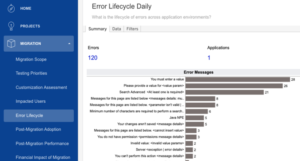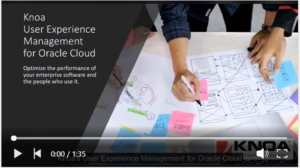This content is brought to you by Knoa Software, a leading provider of employee user-experience management and analytics for Oracle cloud, SAP and others. Learn more
This is a guest post by Beagle Research Group LLC
Cloud computing gave us the ability to charge and pay for software iteratively, by subscription. But we still calculate ROI as if we were making a one-time purchase. There’s more opportunity to track and capture ROI by taking an iterative approach.
Proving ROI on new software is never easy and most people would rather not do the work, at least that’s what I concluded from my first big analyst project nearly 20 years ago.
ROI calculation almost always means collecting data about the before situation so that after implementation you can make a valid comparison and often people simply put it off. Then when they need ROI proof, the best they get is a wet finger in the breeze which displeases CFO’s.
Nearly 20 years ago, Salesforce was a scrappy startup and Siebel Systems was the top dog in CRM, but something upset the Siebel applecart. A small analyst report showed evidence that Siebel customers weren’t getting sufficient ROI, if any, from their investments. The report was clearly damaging to Siebel, especially because the researchers interviewed the very companies that Siebel touted as successes on its website.
CRM was still largely a client-server solution then that took a lot of effort to customize, install, and train. You could routinely cost out a CRM project by multiplying the software cost by two or three. A new implementation easily involved millions of dollars, so proving ROI was uber important for the internal buying process.
The report, indicating that Siebel customers weren’t getting very good ROI was an earthquake for that company, but what could be done to fix it? On the surface, the data looked solid, and even though it only involved a small handful of customers, but it was based on a standard ROI calculation.
I pitched this idea: Many of the Siebel customers who were asked for their ROI data were making it up. They weren’t lying exactly, at least not the researchers, but they were being disingenuous with themselves. They believed they had ROI numbers but in fact they didn’t, and I had to prove it.
The solution was simple enough. You can’t run a true ROI analysis unless you have a before study to compare with an after study. Doing the ‘after’ study should be relatively easy and you’d think the before study would be too, but in the early days of CRM people didn’t know what to measure, so a lot of big companies were simply buying the market leader solution, because everyone couldn’t be wrong, right?
They weren’t all wrong, and Siebel was a good product in its time, and still is by the way. Our research project had to be about ROI methodology not the merits of the product, and here we caught a break.
Our survey of over one thousand Siebel customers showed that only 51 percent admitted they’d done the hard work of performing a pre-implementation study, the rest simply bought the leader.
That would have been fine except that 100 percent of the people asked about ROI were happy to provide numbers — though only half of them, had what we’d call a valid basis.
Our study showed that for those who did perform both before and after studies, ROI was quite good. This was a big win for everybody and although I got some pushback from other vendors (who thought the other study was fine) our results were solid.
I learned a couple of important lessons from this experience. First, people have good but faulty memories and data is the best redoubt. Second, ROI is really hard to prove because it’s a moving target, and today, proving ROI is somewhat different than what it used to be.
Additionally, we’re most familiar with capturing the ROI of a new tool, like a new CRM or ERP system, but more often than not, ROI calculations consider partial data, such as the lower labor costs associated with the initial implementation. But what about the long run? What about the impact on employees’ productivity and adoption over time?
Measuring the ROI of cloud migration – It is mainly about the employees and the processes.
Consider calculating the ROI of migration. Will it include the longer term? Usually, it will not. But it must. Any system ought to provide provable ROI throughout its lifecycle.
For instance, cloud migration should offer significant ROI on optimizing business processes. Are you using the same resources to conduct more or less business now that you have a new cloud-based system? Are your employees more productive working with the new system, or are they buffing up their resumes? Are they working even harder than before to get the same results? Are they succeeding by using the products appropriately in their business processes or are they fighting the new system? In other words, are they struggling and calling the support desk more than is beneficial to getting business done?
Unlike twenty years ago, most companies, certainly the big ones, have already been down the learning curve with ERP, CRM, HCM, and SCM so the ROI benefits that stem from automation have largely been taken. But many, if not most of those twenty-year old systems have exceeded their useful lives and most companies are looking today to the cloud. The ROI game starts again.
Another day, another dollar…
Migration to the cloud will still provide huge one-time savings from avoiding the costs of hardware and software, as well as much of the energy and some of the labor involved in running them. But, in the age of digital disruption, new cloud-based systems have to earn their keep every day. As a practical matter this means they must promote better, faster and more accurate business processing and it means ensuring the systems support employees rather than employees tying themselves in knots to support new systems. Businesses need to be able to measure such systems’ impacts on the employees and ensure they fulfil their promise.
So, in one way we’re back to the fundamental question of how to accurately measure and prove ROI of your cloud migration.
Today, the answer doesn’t simply involve performing a single before and after study. To maximize investment, we need to check on the ROI frequently once the cloud system is operational.
One answer I’ve found involves capturing metadata from employee usage of systems, both the old ones and the newly deployed ones. It also means capturing metadata from associated support systems like the Help Desk and then using analytics to spot trends so that the organization can take remedial action where it is needed most.
How should cloud migration ROI be calculated today?
Solutions that focus on employee usage analytics in cloud applications, should not only allow teams to plan and prioritize the migration process, and measure success (or failure) in terms of employee productivity and adoption indications, but they should also offer a clear way to measure the cumulative ROI of the migration, and more importantly, to allow organizations to significantly optimize it.
Knoa Software provides a good example of this approach. The company first proved its solution on the SAP ERP suite on large deployments where common before-and-after studies prove either difficult, time consuming or both. It works by capturing metadata about the user experience a category of software often referred to as UEM or User Experience Management.
Knoa use cases fit the most important areas where ROI originates including migration, application development, support desk, business process optimization, end-user training, onboarding new employees and more.
A report of Oracle cloud application user errors by category (Knoa UEM for Oracle Cloud)
How does it provide analytics to measure the ROI of cloud migration? It sets testing targets and validates performance improvements by measuring adoption of new applications (the metadata). Knoa also prioritizes and measures the impact of application support initiatives.
In use, Knoa performs learning assessments and provides targeted end-user training and then measures training’s effectiveness. At the critical business process level, the system both identifies business process optimization opportunities and measures process adoption. Most importantly Knoa can verify user compliance with best practices.
So, by capturing employee usage and user experience data in all of these areas, and applying analytics, even with large and complex systems, managers can pinpoint where in their processing bottlenecks originate and form action plans to remedy them.
Most importantly, organizations can begin to develop metrics about seasonal use variations and the effect of new employees on processing as well as identifying super-users, people to be studied and perhaps emulated. Taken together this drives ROI on day one and for the life of the system.
Conclusions
Knoa is now applying its technology to the challenges of Oracle customers transitioning to the cloud. Today, there are well over 425,000 Oracle customers and they include many of the biggest and most complex businesses on the planet. Most of them will need to transition (if not yet started) in the coming years because the paradigm shift that cloud migration offers represents significant financial rewards.
But a running business will prudently seek to identify and avoid the pitfalls that can crop up in such a paradigm shift. That’s where Knoa comes in. In the era of digital disruption, businesses will routinely need to understand how well their systems support the business and not simply on day one but for the life cycle. With an employee usage and user experience monitoring solution they can see into their live-processes and gain insight into ROI like never before.



